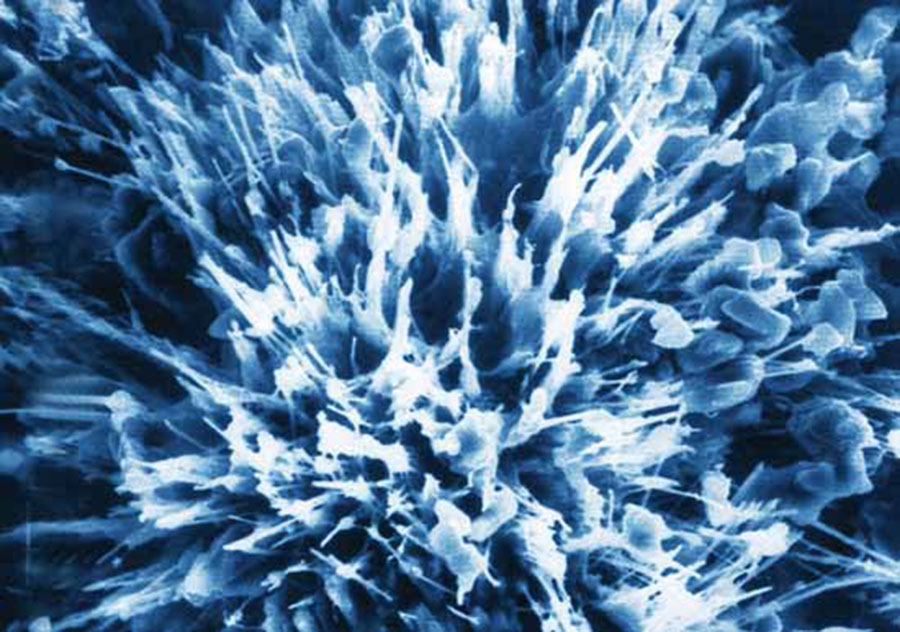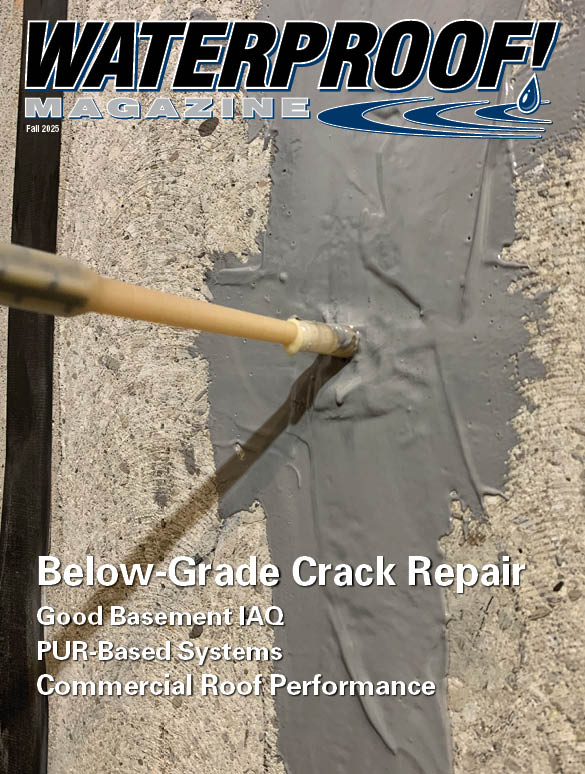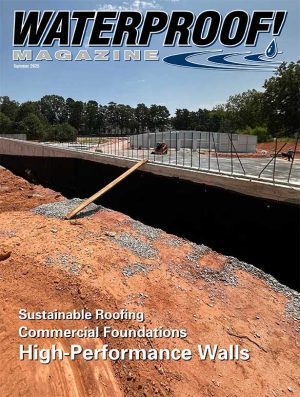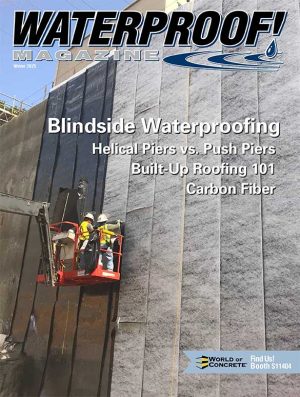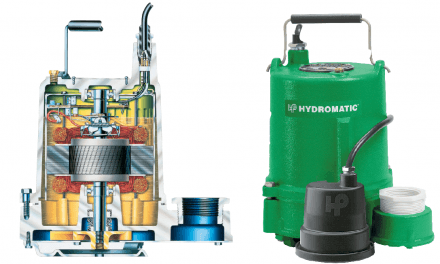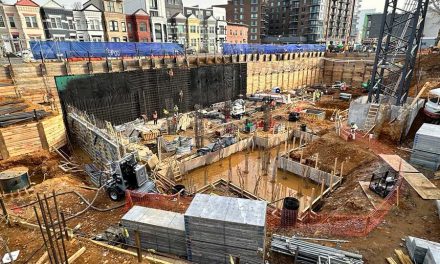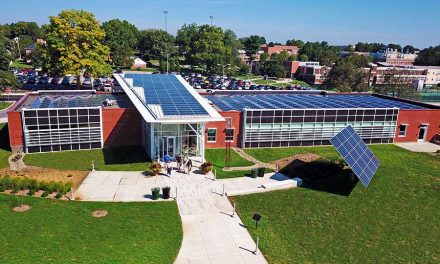Over the past ten years, sustainable construction practices and green building rating systems have become increasingly popular.
Produced by a few different manufacturers, these products can be applied as a slurry coat, integral admixture or dry-shake powder for new slab construction. It has been used in many of the most prominent green-build projects in North America, including several that have been certified LEED-Platinum, the highest honor awarded by the U.S. Green Building Council.
How it Works
The chemical composition of each brand of crystalline waterproofing is different, but the basic technology is the same. In the presence of water, the products react with calcium hydroxide and other byproducts of cement hydration to create a microscopic non-soluble crystalline formation that fills the pores and micro-cracks in concrete. As long as moisture remains present, the crystals continue to grow, potentially reaching lengths of many inches.
The same chemical reaction will occur even if the exposure to water occurs years after the crystalline waterproofing was installed. The ability to reactivate in the presence of water gives crystalline-treated concrete the ability to “self-seal.” When cracks form due to curing shrinkage, settling, seismic activity, etc., water entering through them causes new crystals to form and grow, blocking and filling the cracks. This reaction will occur for the entire life of the concrete structure, automatically sealing cracks up to half a millimeter (1/64 inch) wide. Obviously, this can help to dramatically reduce the long-term maintenance and repair costs.
Although crystalline waterproofing can be applied in several different ways, adding it to the mix at the batch plant has gained popularity in recent years. (Other methods include shaking a dry powder onto green concrete and brushing or spraying it on as a slurry coat for existing concrete structures). Slurries and dry-shake applications penetrate from the surface only, but admixtures have the benefit of ensuring that the crystalline formation occurs uniformly throughout the concrete. Most admixtures are powdered, although Aquafin markets a liquid admixture which claims to eliminate the risk of clumping and enhances distribution. It should be noted that Xypex crystalline admixture is marketed in soluble bags that have over ten years of field use with negligible reports of clumping or dispersion issues.
Advantages
Crystalline waterproofing has several unique green construction benefits.
From an application standpoint, it requires far fewer protections for the waterproofing crew. There are no Volatile Organic Compounds (VOCs). Respirators and disposable coveralls are unnecessary. Air quality is unaffected. With the admixture products, the waterproofing is installed at the same time as the concrete, so it eliminates all the extra labor and material resources needed to install traditional membranes and coatings. Frequently, these products can reduce the amount of onsite equipment, and significantly decrease the amount of excavation and backfill required, as crystalline-enhanced concrete can be applied blindside, instead of needing the larger construction footprint that membrane installation typically calls for. So there’s less material, less waste, and less digging.
Crystalline requires no solvents, and there are no petroleum-based products to leach into the environment. The technology is so safe that many crystalline products have been certified as safe for use with potable water tanks.
Finally, the waterproofing is permanent, and hairline fractures will self-seal for the life of the structure. Finally, at the end of the building’s life span, the concrete can easily be recycled into aggregate or fill, with no membranes or coatings to remove.
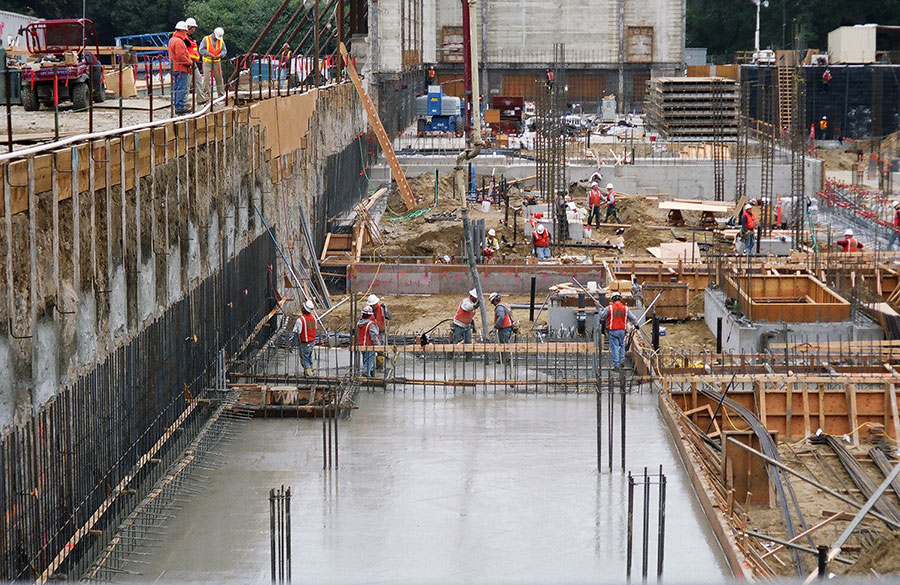
Crystalline waterproofing was used to seal the more than 4,500 cubic yards of concrete used to construct the California Academy of Sciences, the first LEED-Platinum certified museum.
Contributions to LEED
Currently, the most popular green building rating system is administered by the U.S. Green Building Council (USGBC). Their Leadership in Energy and Environmental Design (LEED) program has certified more than a billion square feet of new construction since being launched. Periodically updated since its inception in 2000, the cur-
rent iteration—LEEDv4—awards points across a handful of categories, such as water and energy conservation, waste reduction, and habitat conservation. Upon completion, the point tallies are verified and the project is certified. Those that go beyond the minimum point requirements can be certified at silver, gold or platinum levels.
Kryton, Xypex, Aquafin and others which market an entire line of various crystalline waterproofing products can contribute to the following LEED credits:
Sustainable Sites: Crystalline waterproofing admixture can contribute up to two points under Credit 5.1 Site Development: Protect or Restore Habitat by reducing the size of excavation is required. Because the product is added directly to the concrete mix, there’s no need to excavate an area for workers applying physical membranes.
Materials & Resources: Crystalline coatings can contribute an additional point under Credit 2.1: Construction Waste Management due to its recyclability. Spray-applied coatings and self-adhered membranes are difficult to remove, so this concrete usually goes straight to the landfill. Crystalline-treated concrete, though, is easily recycled post-demolition, eliminating waste. As noted above, some of these admixtures are available in mixer-ready, pulpable bags, which eliminates packaging waste around the jobsite.
Environmental Quality: Indoor air quality is a significant factor under current LEED guidelines. Because crystalline waterproofing involves no volatile organic compounds, and does not affect air quality, it can contribute up to one point under Credit 4.2 Low-Emitting Materials: Paints & Coatings.
Innovative Design: LEED rewards points for the longevity and durability of the structure. Up to one point can be awarded in this category because crystalline products stop corrosion, increase freeze/thaw durability, and protect against chemical attack, carbonation and other detrimental effects.
Conclusion
“Crystalline waterproofing products provide many key advantages to concrete structures and contribute toward LEED certification,” says Chris Chen, director at The Penetron Group. “In their report on Chemical Admixtures for Concrete, the ACI states that crystalline admixtures—as true Permeability-Reducing Admixtures for Hydrostatic conditions (PRAHs)—are sufficiently stable to resist water under pressure and can eliminate traditional petrochemical-based membranes.”
He points out that in addition to LEED benefits listed above, they enable shortened construction schedules, do not require additional energy input (heat or electricity) and do not create environmentally unfriendly waste at the end of a building’s useful life, making this type of product very attractive.
Crystalline waterproofing sys-tems are gaining acceptance as the preferred treatment method for eco-friendly construction. They provide a solution that’s not only sustainable and environmentally-sensitive, but also effective, easy to use, and extremely cost-effective.
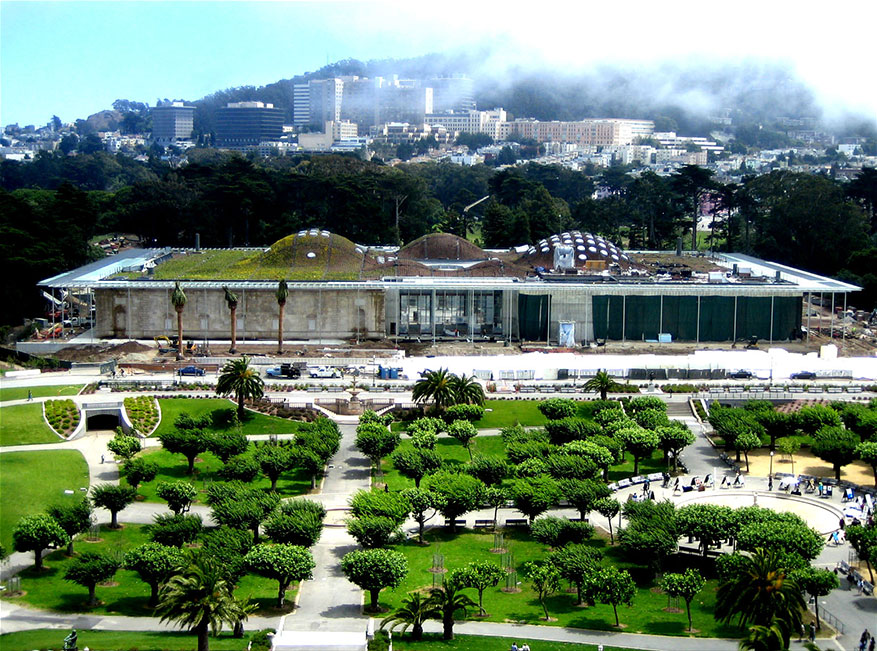
CASE STUDY 1: California Academy of Sciences
Upon completion in 2008, The California Academy of Sciences was the largest public LEED-Platinum certified building in the world. Used in both the shotcrete and conventionally-placed concrete, Xypex’s crystalline admix played a central role in waterproofing the structure.
The California Academy of Science in San Francisco, California is one of the largest natural history museums in the world. As a result of earthquake damage to the original building, construction began on a new, completely re-designed museum in 2005. Finished in 2008, it covers 400,000 sq. ft. and ranks among the top-tier natural history museums in the United States. It’s also one of the greenest. At the time of construction it was the largest public LEED Platinum-certified building in the world.
Xypex waterproofing helped this building achieve its platinum rating by allowing for the elimination of waterproofing membranes in the structure. The foundation is four levels below grade and was constructed using structural shotcrete techniques for placement of the vertical concrete. Both the shotcrete walls and the normally placed slab were treated with 2.5% Xypex Admix C-500 to create a waterproof tank foundation. A drainage layer and weeping tile were installed on the outside of foundation to provide a drain path for water. Xypex Admix C-500 was also used to waterproof all of the water retaining pools and structures within the museum.
Xypex crystalline waterproofing was used in more than 4,500 cubic yards of conventional concrete and shotcrete. The use of Xypex Admix C-500 provided a cost effective solution for waterproofing of the structure and water holding features of the California Academy of Science
In addition to eco-friendly waterproofing, the building boasts a 2.5-acre green roof, and used 20,000 cubic yards of recycled concrete as aggregate and 5,000 tons of recycled steel.
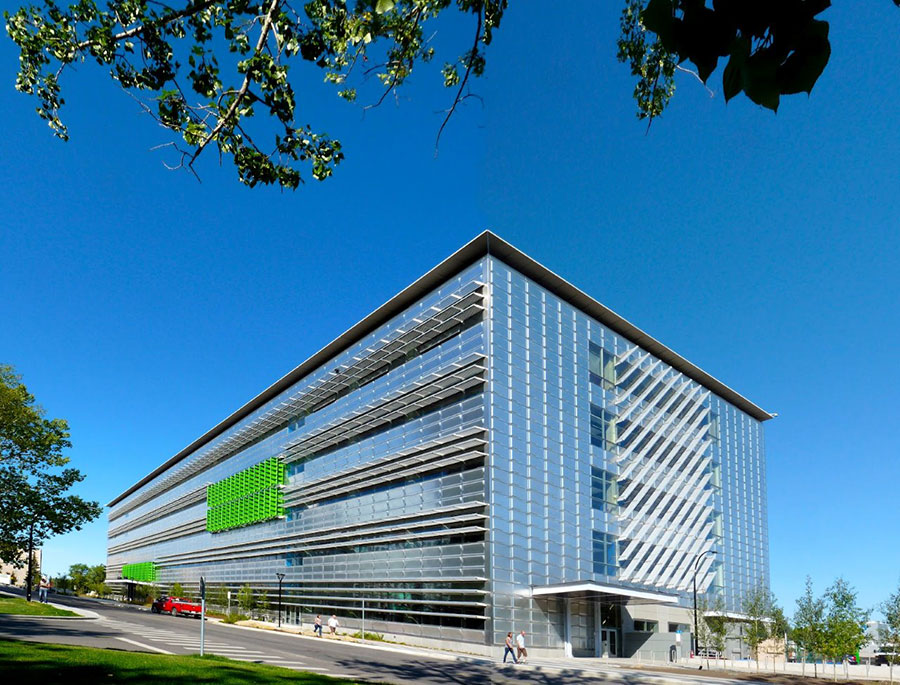
CASE STUDY 2: University of Calgary Laboratory
The five-story EEEL laboratory at the University of Calgary is also certified LEED-Platinum. All of the structural elements of the building were made from concrete enhanced with a crystalline admix from Penetron.
Founded in 1966 and home to over 30,000 students and 1,800 faculty members, the University of Calgary has announced a goal to become one of Canada’s top five research universities by 2016. As part of that long-term strategy, they recently constructed an Energy Environment Experiential Learning (EEEL) laboratory.
Five stories tall with a footprint about the area of a football field, the EEEL building provides room for over 1,000 students in labs, classrooms and a theater. Laboratory buildings typically use large amounts of energy, but efficiency was a key part of the design and the finished structure uses 78% less energy than a typical laboratory. In fact, the EEEL is rated as one of the most energy efficient buildings in North America.
Energy efficiency is not the only eco-friendly aspect of the building. Concrete was used for virtually all the structural elements (foundation, walls, floors, interior shear walls, etc.) and designers chose a crystalline waterproofing admix from Penetron treat all the below grade concrete to maximize durability and water resistance. Designers DIALOG (a Canadian interdisciplinary design firm) and Perkins & Will (a global architecture firm) chose Penetron due to its ability to resist extreme hydrostatic pressure.
Additional green measures include underground concrete tubes to move outdoor air inside for cooling and heating and rainwater and greywater storage for plumbing.
The EEEL was certified as LEED-Platinum by the USGBC as one of the most energy efficient laboratories in North America.
“The EEEL features an impressive array of green technologies,” summarizes Chris Chen, director of the Penetron Group. “The waterproofing and durability-enhancing properties of Penetron-treated concrete are invisible, but play an important part in the building’s overall environmental footprint.”
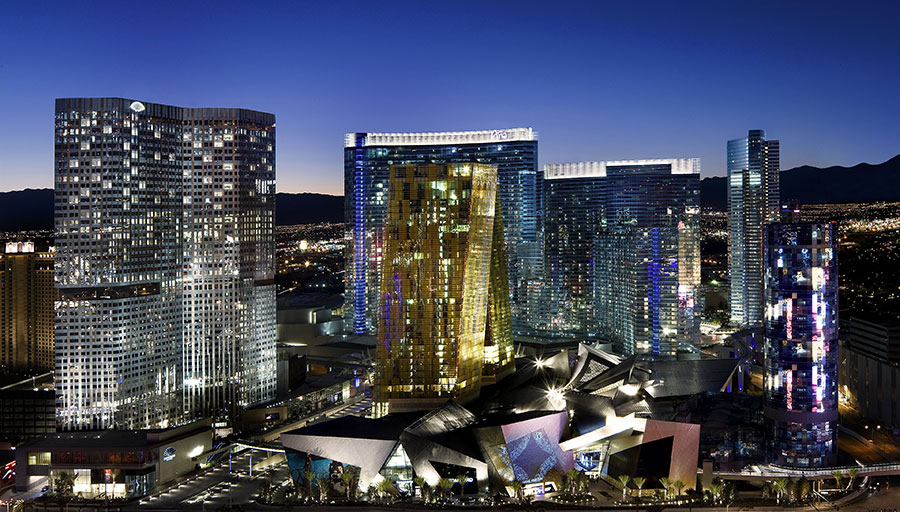
CASE STUDY 3: CityCenter, Las Vegas
CityCenter is the largest private construction project in the world. Certified LEED-Gold, all below-grade concrete was waterproofed with Kryton’s Krystol Internal Membrane.
CityCenter is the largest construction project ever built in the United States without government funding. The multi-building development near downtown Las Vegas is interlinked by a sophisticated underground valet tunnel. Despite the arid desert surrounding it, Las Vegas began as an oasis, and the building site sits directly atop a shallow aquifer which runs underneath the entire project.
To waterproof the valet tunnel, elevator pits, swimming pools, the Cirque de Soleil water tank and all other critical below grade areas, designers used crystalline waterproofing system from Kryton.
The project aimed to achieve LEED certification, and it achieved Gold. CityCenter is the first of any hotel, retail, or residential project in Las Vegas to attain this level of LEED.
Fall 2025 Back Issue
Price range: $4.95 through $5.95
PUR-Based Systems: A High-Performance Concrete Protection and Traffic Coating Solution
Breathing Easy With Good Indoor Air Quality, Starting with the Basement
Restoration vs. Replacement: Maximizing Commercial Roof Performance
Below-Grade Crack Repair Solutions
Four Decades of Proof: Why Silicone Coatings and Sealants Stand the Test of Time
Case Study: New York State Capitol Building
Description
Description
PUR-Based Systems: A High-Performance Concrete Protection and Traffic Coating Solution
By Tom Stuewe, Senior Product Manager, Siplast
In today’s fast-paced commercial construction landscape, polyurea and polyurethane-based deck coating systems have become indispensable for their exceptional combination of durability, flexibility, and performance.
Breathing Easy With Good Indoor Air Quality, Starting with the Basement
By Vanessa Salvia
Even if you don’t spend a lot of time in your basement, controlling the humidity and filtering that air before it moves to the upper levels of the home will improve your comfort and indoor air quality in the rest of the house.
Restoration vs. Replacement: Maximizing Commercial Roof Performance
By Vanessa Salvia
Commercial roofing presents challenges that set it apart from residential applications, such as being expansive surfaces that are almost flat. Proper maintenance programs can extend roof life well beyond design specifications and prevent the majority of warranty claims.
Below-Grade Crack Repair Solutions
By Vanessa Salvia
Modern techniques and materials are revolutionizing how contractors approach structural crack repair in basements, combining traditional injection methods with innovative carbon fiber reinforcement systems.
Four Decades of Proof: Why Silicone Coatings and Sealants Stand the Test of Time
By Errol Bull, Technical Services Manager at Momentive Performance Materials
How do you know if waterproofing solutions will stand the test of time? One study, started in 1983, seeks to answer that question.
Case Study: New York State Capitol Building
A centerpiece in the heart of Albany, the New York State Capitol Building’s central courtyard required updates to its roofing and cladding.
Additional Info
Additional information
| Weight | N/A |
|---|---|
| Magazine Format | Digital Download Magazine, Print Mailed Magazine |

